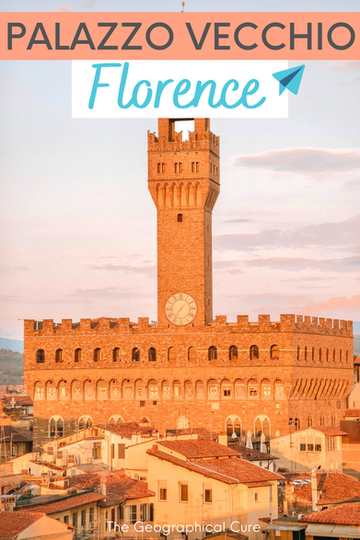The Palazzo Vecchio is the civic heart of Florence and one of its most hallowed historic sites.
The palazzo is a doughty medieval fortress on the outside. Inside, it’s a resplendent Renaissance palace filled with artistic treasures.
It’s one of Florence’s most important landmarks. In some ways, Palazzo Vecchio explains the entire history of Florence.
The palace dates from the 13th century. Like the Duomo, it was originally designed by famed Florentine architect Arnolfo di Cambio.
The Palazzo Vecchio, with its distinctive crenellations and soaring tower, stands as an iconic symbol of Florence. This historic building once served as the center of power for the Republic of Florence, housing the City Council that ruled the city.
Located in the stunning Piazza della Signoria, the Palazzo Vecchio is set in a square that doubles as an open-air art gallery. Inside the palace, visitors are treated to a wealth of artistic treasures.
In this guide, I’ll give you a bit of history on the palace and tell you everything to see inside. You can expect to see:
- Michelozzo Courtyard
- Hall of the Five Hundred
- Studio of Francesco I
- Apartments of Leo X
- Apartment of the Elements
- Apartment of Eleanora
- Hall of the Lilies
- Roman Theater of Fiorentina
- Arnolfo Tower
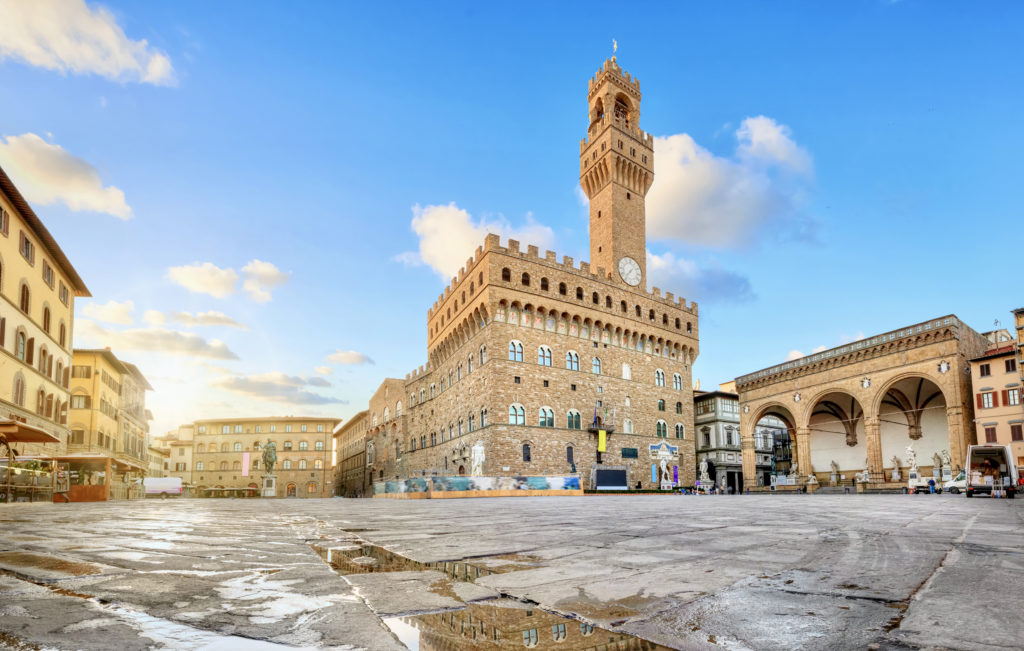
Mini History of the Palazzo Vecchio
The palazzo itself has a fascinating history. In 1298, Florentines decided to build a palace to house the governmental entities of the republic.
They hired Arnolfo di Cambio, architect of Florence Cathedral and the Basilica of Santa Croce.
In the 16th century, Cosimo I de’ Medici turned the Palazzo Vecchio into the official ducal residence. The palace was then known as the Palazzo della Signoria.
When Cosimo moved to the Pitti Palace, he renamed it Palazzo Vecchio, or old palace. Today, the palazzo still houses the city hall.
The Palazzo Vecchio is the setting for key moments in Florence’s history. It was famously the scene of one of Renaissance Florence’s most infamous attempted coups.
In 1478, the Pazzi family and Pope Sixtus tried, but failed, to oust the ruling Medici family. They plotted to kill both Lorenzo the Magnificent and his brother Giuliano.
Giuliano was murdered. Lorenzo escaped and exacted revenge. In just a few hours, the killers and conspirators (including the pope’s nephew) were captured.
They were hung from the second floor ramparts of the Palazzo Vecchio. Incensed, the pope excommunicated Lorenzo.
The palace is also linked to the rise of the fiery Dominican preacher Girolamo Savonarola.
Savonarola denounced the excesses of clerical and despotic power. He told Florentines the apocalypse was coming and to save themselves through self censorship.
The doomsday preacher eventually ousted the Medici and established a theocracy in Florence for several years. But Savonarola went too far.
In the 1497 “Bonfire of the Vanities,” he destroyed works of art in the Piazza della Signoria. The pleasure loving citizens of Florence had enough and didn’t want their cultural legacy destroyed.
In 1498, Savonarola was defrocked and imprisoned in the Palazzo Vecchio for heresy. After being tried and convicted, he was executed in the Piazza della Signoria.
A circular plaque near the Palazzo Vecchio’s entrance marks the spot of Savonarola’s execution.
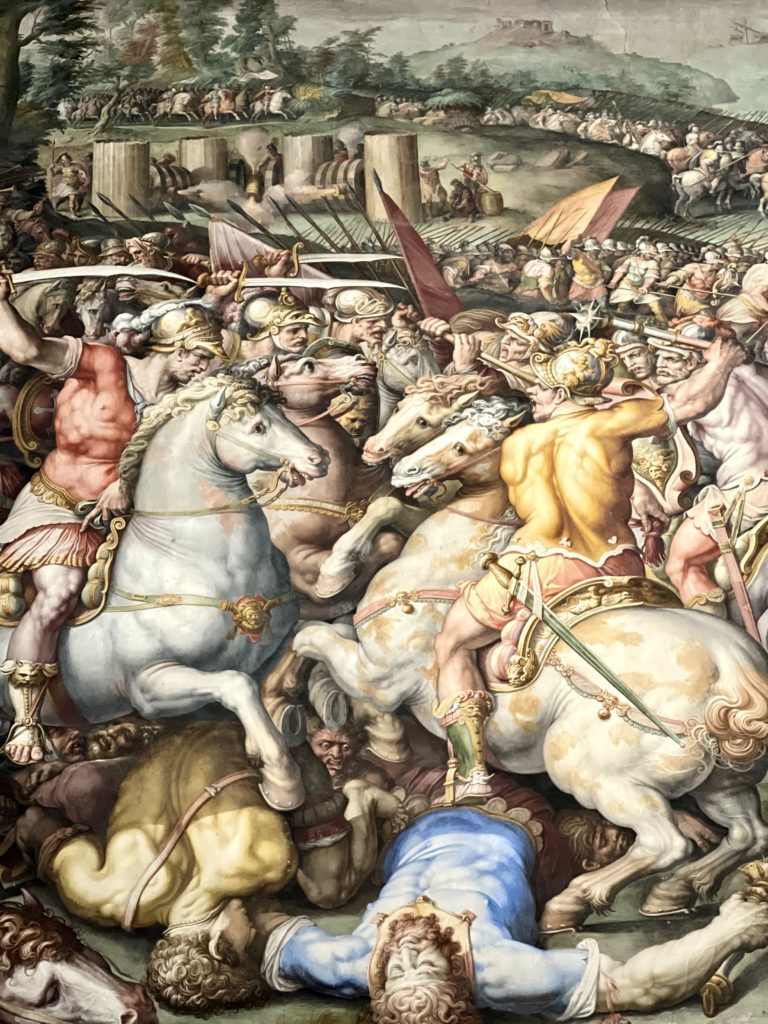
Guide To The Palazzo Vecchio: What To See
Why visit the Palazzo Vecchio?
Because it’s so much more than just a museum! The palace is living breathing history.
Let’s step through the entrance — guarded by a replica of Michelangelo’s David and Bandinelli’s Hercules — and take a peak inside.
1. The Michelozzo Courtyard
In contrast to the rather dour rusticated exterior of Palazzo Vecchio, there’s a surprising playfulness inside.
You begin in the charming courtyard, designed by the famed architect Michelozzo in 1453.
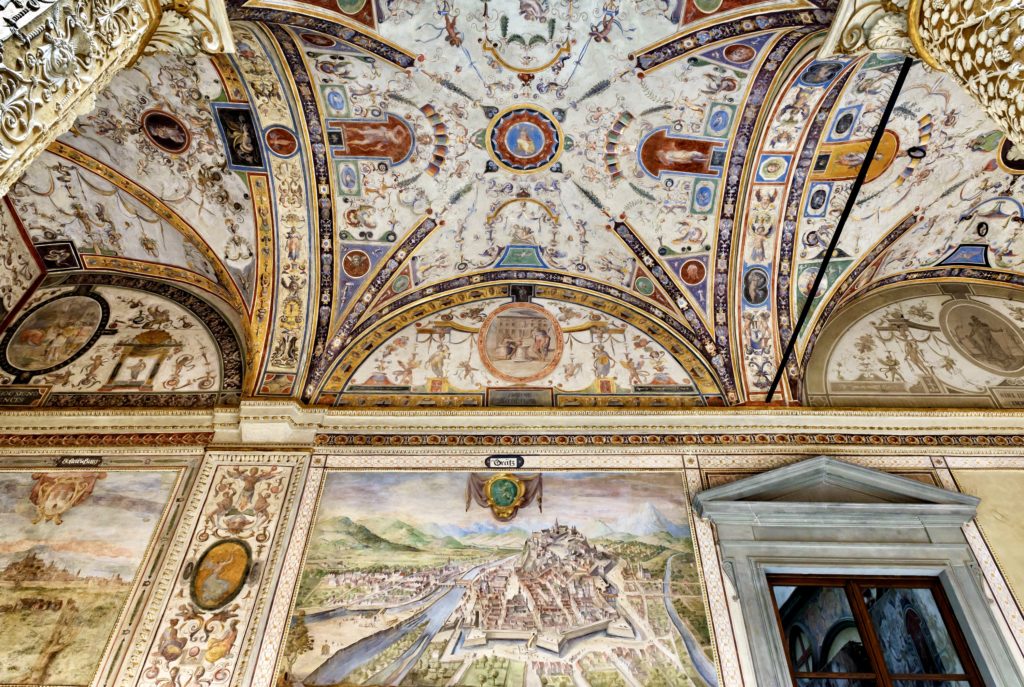
He was hired to give the palazzo a makeover when Cosimo’s son married Hapsburg Princess Joanna of Austria in 1565.
The courtyard has intricately carved and gilded columns, beautiful grotesque style ceiling frescos, and sculptures.
Grostesque frescos became fashionable in the Renaissance after the discovery of Domus Aurea, also known as Nero’s Golden House. The ancient palace of Emperor Nero was filled with a fanciful mix of animal, human, and plant frescos.
To welcome Joanna, Cosimo had Giorgio Vasari decorate the courtyard walls with frescos of Hapsburg estates in Austria.
Unfortunately, they’re not in very good condition due to being exposed to the elements.
In addition, Vasari was in a hurry when he created them. Like Leonardo with The Last Supper, Vasari painted the scenes in fresco secco (dry fresco) not the more durable fresco buon (true fresco on wet plaster).
In the center, an iron putti tops a fountain by artist Battista del Tadda. The putti and his dolphin are a copy of the original carved by sculptor Andrea del Verocchio, which was moved inside the place.
The water that playfully squirts from the dolphin’s nostrils comes from the Boboli Gardens at Palazzo Pitti.
2. Hall of the Five Hundred
The first floor of the Palazzo Vecchio was for public meetings. It’s dominated by the Hall of the Five Hundred, the Salone dei Cinquecento. The name derived from the 500 man assembly that met there when Florence was a republic.
The Hall of 500 is the largest room in Italy built for a palace. Savonarola commissioned it in 1494.
He sought to establish a more democratic government because he thought the Medici were despots. Consistent with his reforms, Savonarola created the Council of Five Hundred to govern Florence.
In Savonarola’s hands, the hall was monastic and spartan. In the mid 16th century, Cosimo I commissioned Giorgio Vasari to lavishly decorate the place.
In particular, Vasari painted a massive fresco cycle depicting the The Battle of Marciano, in which Florence triumphed over rivals Pisa and Siena. Vasari also painted the 39 gilded ceiling panels, which tell the life story of Cosimo I.
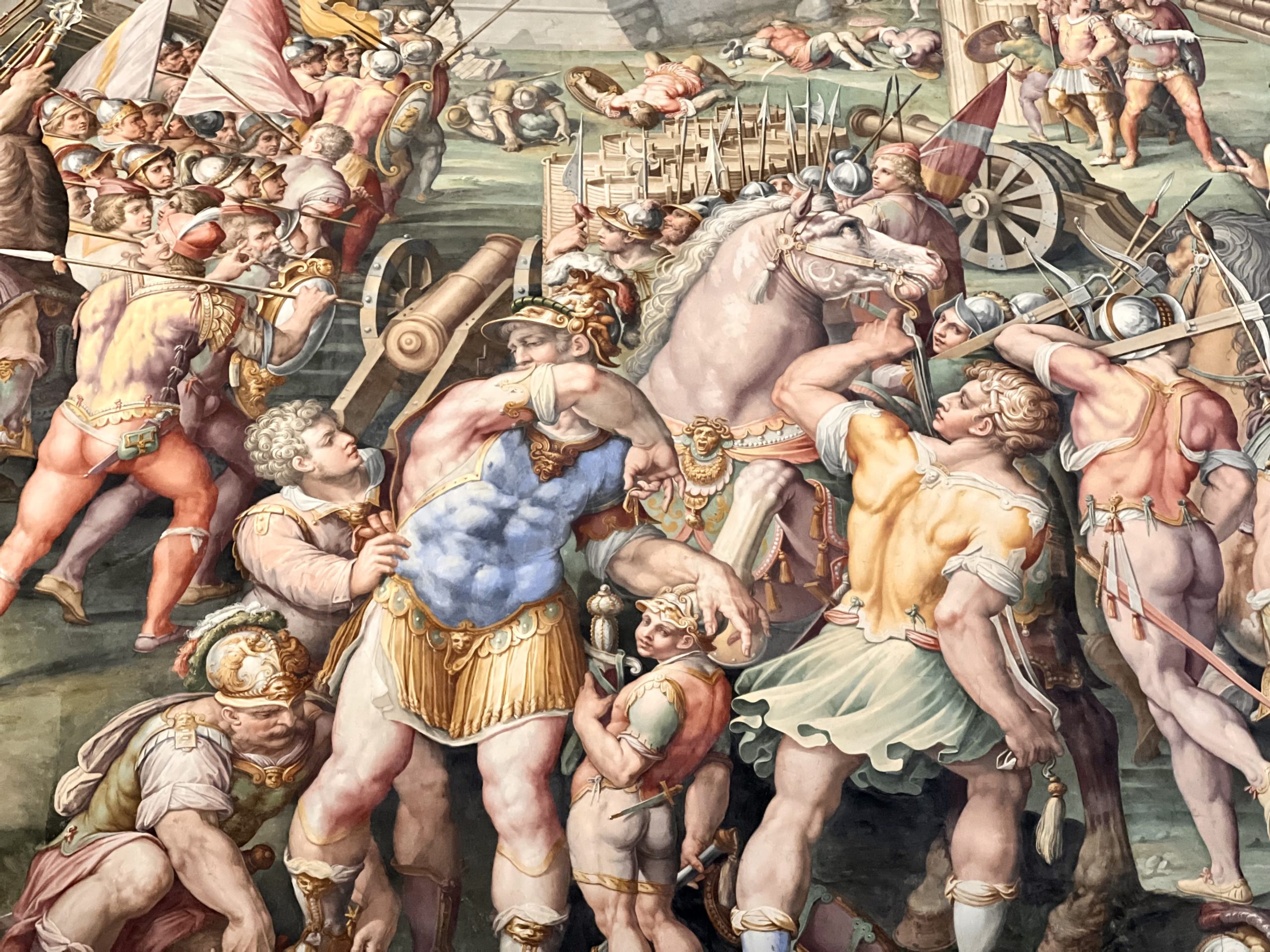
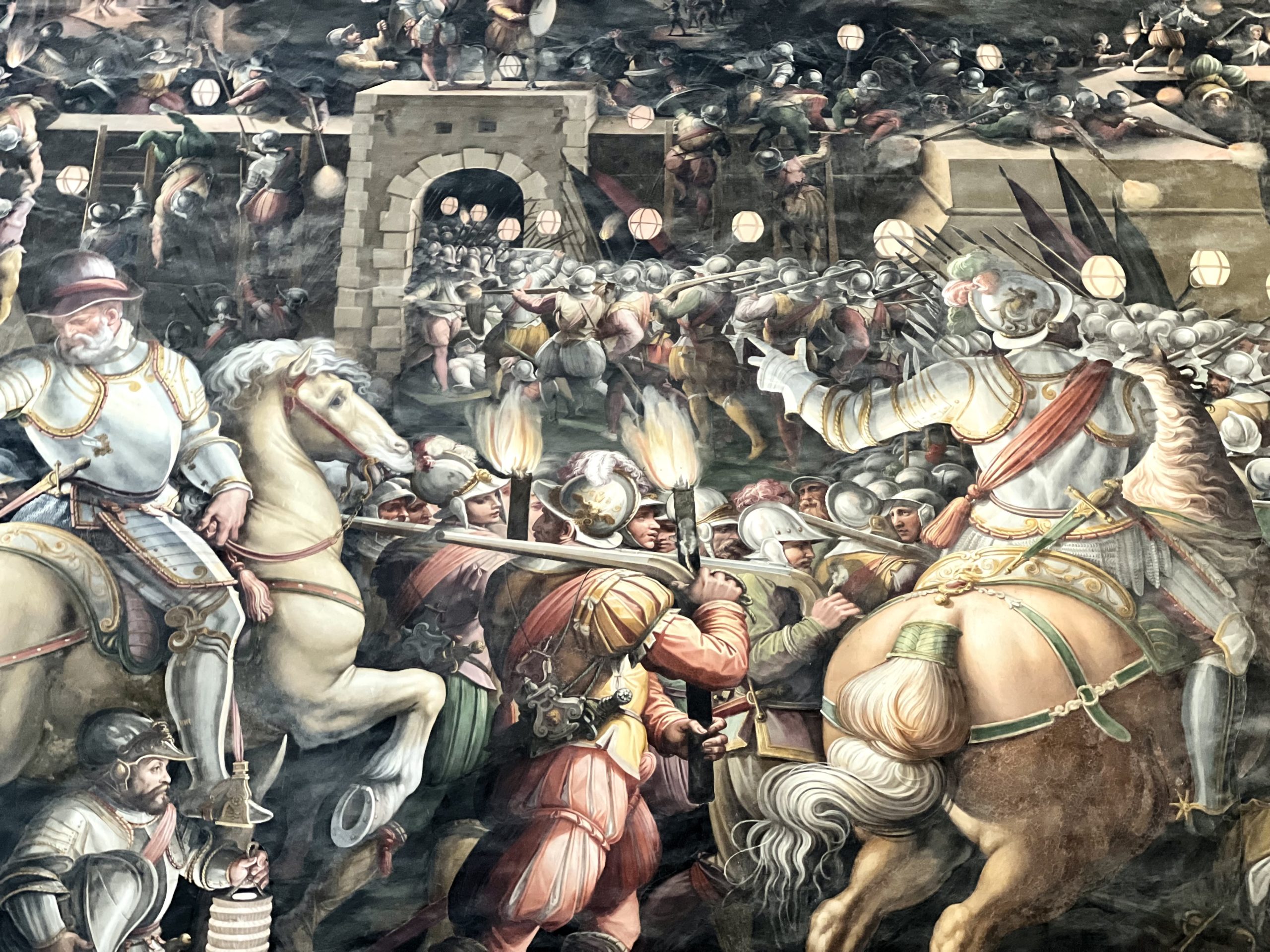
But before Vasari came Leonardo da Vinci. Some scholars believe that a long lost Leonardo is hidden behind one of the Vasari frescos — The Battle of Anghiari.
What happened to it?
In 1503, the Signoria (or city council) commissioned Leonardo to paint a massive fresco in the room celebrating Florence’s victory in 1440 over Milan in the Battle of Anghiari. Leonardo created a cartoon of the battle with horses and riders fighting to the death.
Leonardo painted the 15 x 20 central panel, but never finished the commissioned fresco. Unfortunately, Leonardo experimented with paint (adding wax), as he did with The Last Supper in Milan.
And he used braziers to increase drying speed, which made the paint run. Frustrated by the failed experiment, Leonardo abandoned the project. (As he frequently did with commissions.)
Still, people came to admire Leonardo’s unfinished fresco. Other Renaissance artists thought it was Leonardo’s best work yet and made copies.
There’s a famous version by Peter Paul Rubens in the Louvre.
Fifty years later, in 1563, Vasari was commissioned to repaint the unfinished walls. Vasari was a great admirer of Leonardo.
Legend holds that, instead of painting over Leonardo’s work, Vasari built a false wall over the fresco to preserve it. Then, he painted The Battle of Marciano on the false wall.
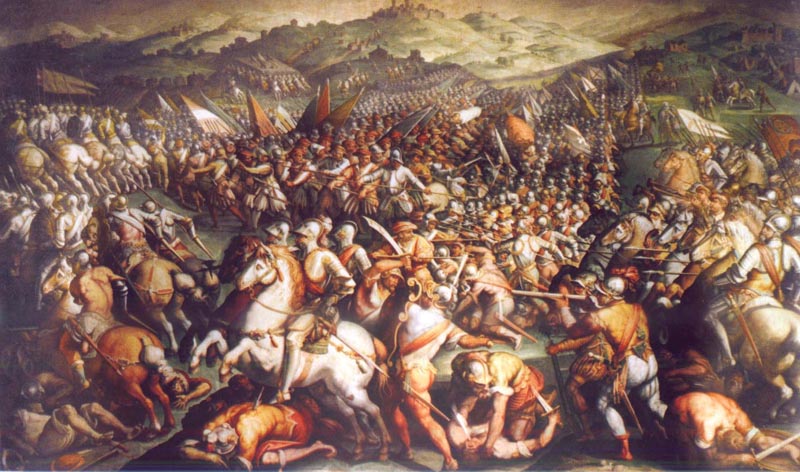
Vasari even left a cryptic clue. On a flag on his fresco, he wrote the phrase “He who looks will find.”
Only 15 known Leonardo’s exist, making this possibility tantalizing.
In 2012, an air gap was discovered behind Vasari’s painting. Siting historic documentation, an art diagnostician got permission to drill tiny holes through cracks in the wall housing Vasari’s work.
The project was backed by the National Geographic Society and had the support of the mayor of Florence, Matteo Renzi. Traces of pigment that matched Leonardo’s Battle of Anghiari were found.
But then a hew and cry began. Some art historians didn’t want the Vasari frescos, recently restored, to be damaged in any way.
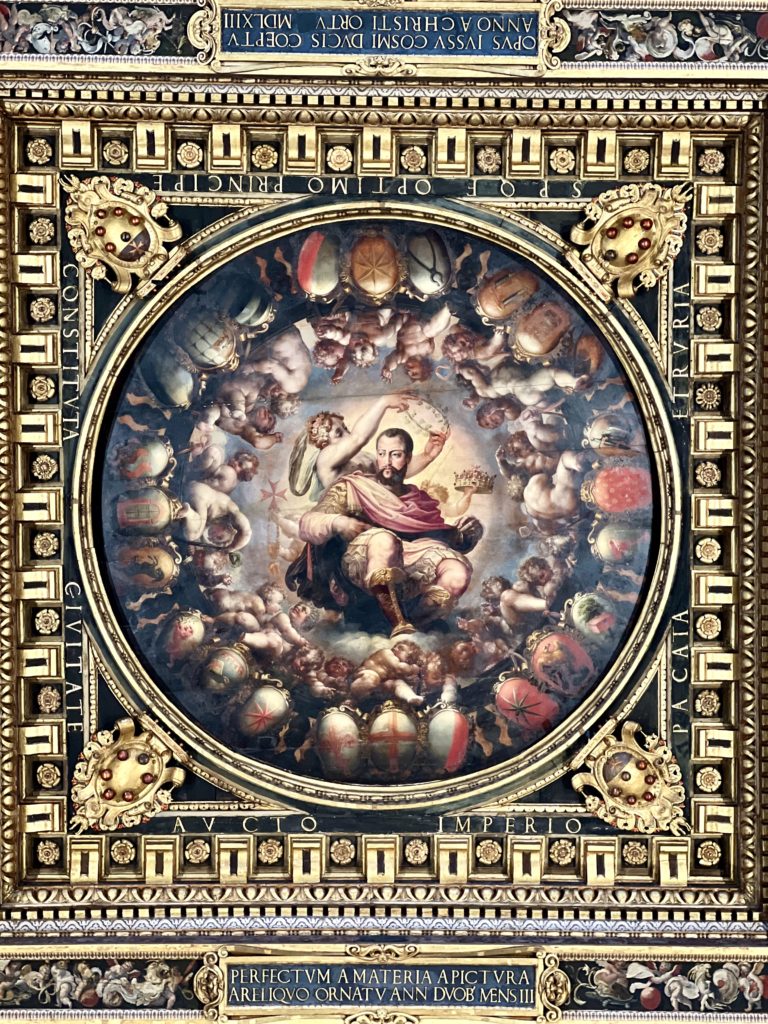
The project was shut down. Still, Florence’s mayor remains interested in discovering the lost Leonardo.
Another masterpiece of the Hall of Five Hundred is Michelangelo’s Genio della Vittoria, or Genius of Victory, sculpture.
It was carved for the Tomb of Pope Julius II, another project that didn’t come to fruition. It was found in Michelangelo’s house when he died and donated to the Medici family.
In the unfinished sculpture, a young man stands victorious with his foot on a vanquished foe. It’s a symbol of Julius II, who was known as the “Warrior Pope.”
The model was one of Michelangelo’s students, Tomasso dei Cavalieri. Michelangelo was in love with Cavalieri and wrote romantic poetry for him.
3. Studio of Francesco I
The Studio of Franceso I is a secret side room that’s an annex to the Hall of Five Hundred. It’s vaulted and shaped like a Florentine chest or jewelry box, with no windows. It was considered one of the first and finest examples of a cabinet of curiosities.
Built in 1569-70, the studio is decorated floor to ceiling with Mannerist paintings by Vasari and a dozen others. The paintings front 20 functioning cupboards.
The portraits of Cosimo I and Eleanora are by the late Renaissance Mannerist painter Bronzino.
From a peep hole, Francesco would spy on meetings in the Hall of Five Hundred. Behind two of the painted panels lie a private alchemy room and a secret staircase. The study was disassembled in its time and only reassembled in the 20th century.
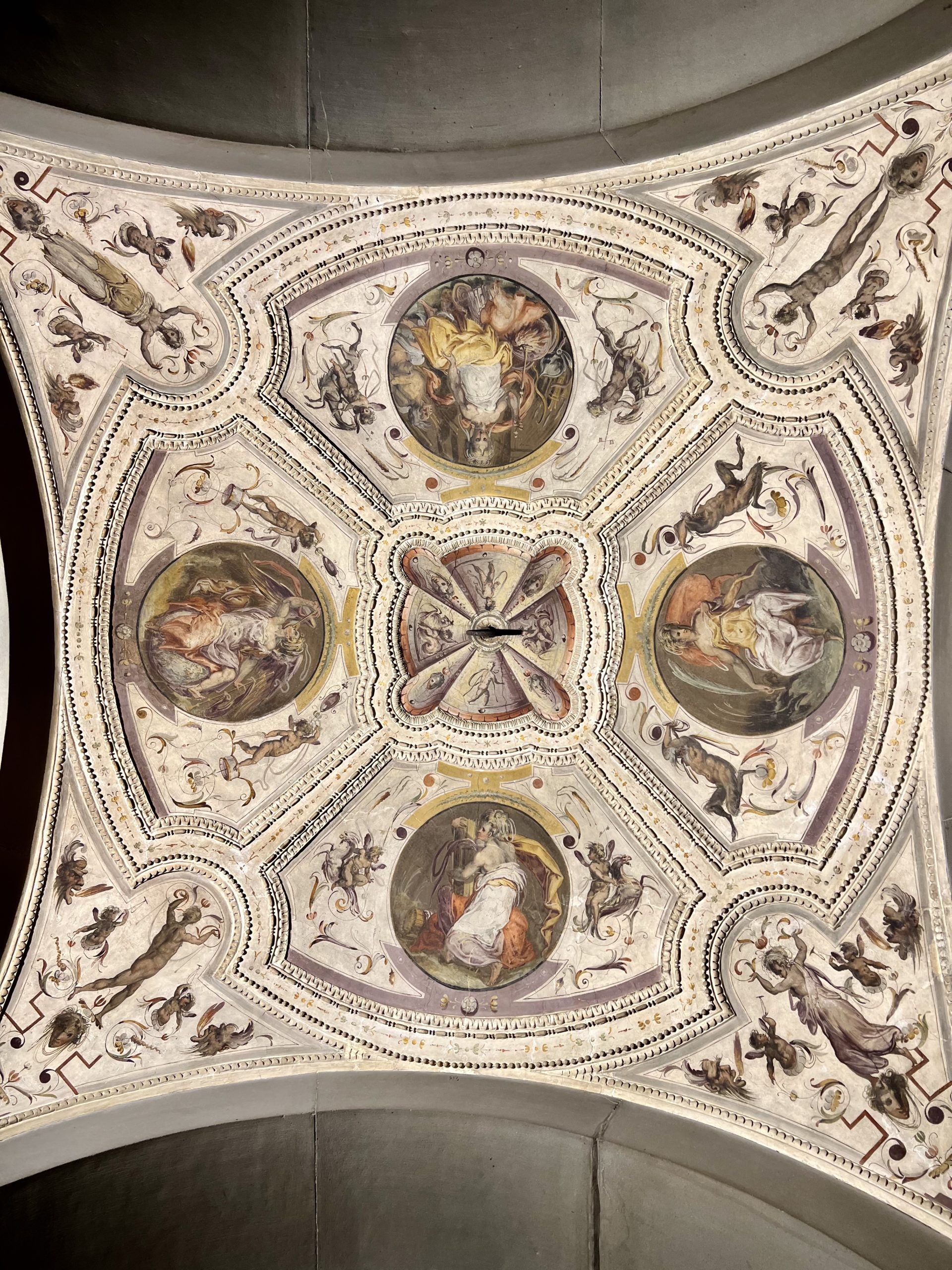
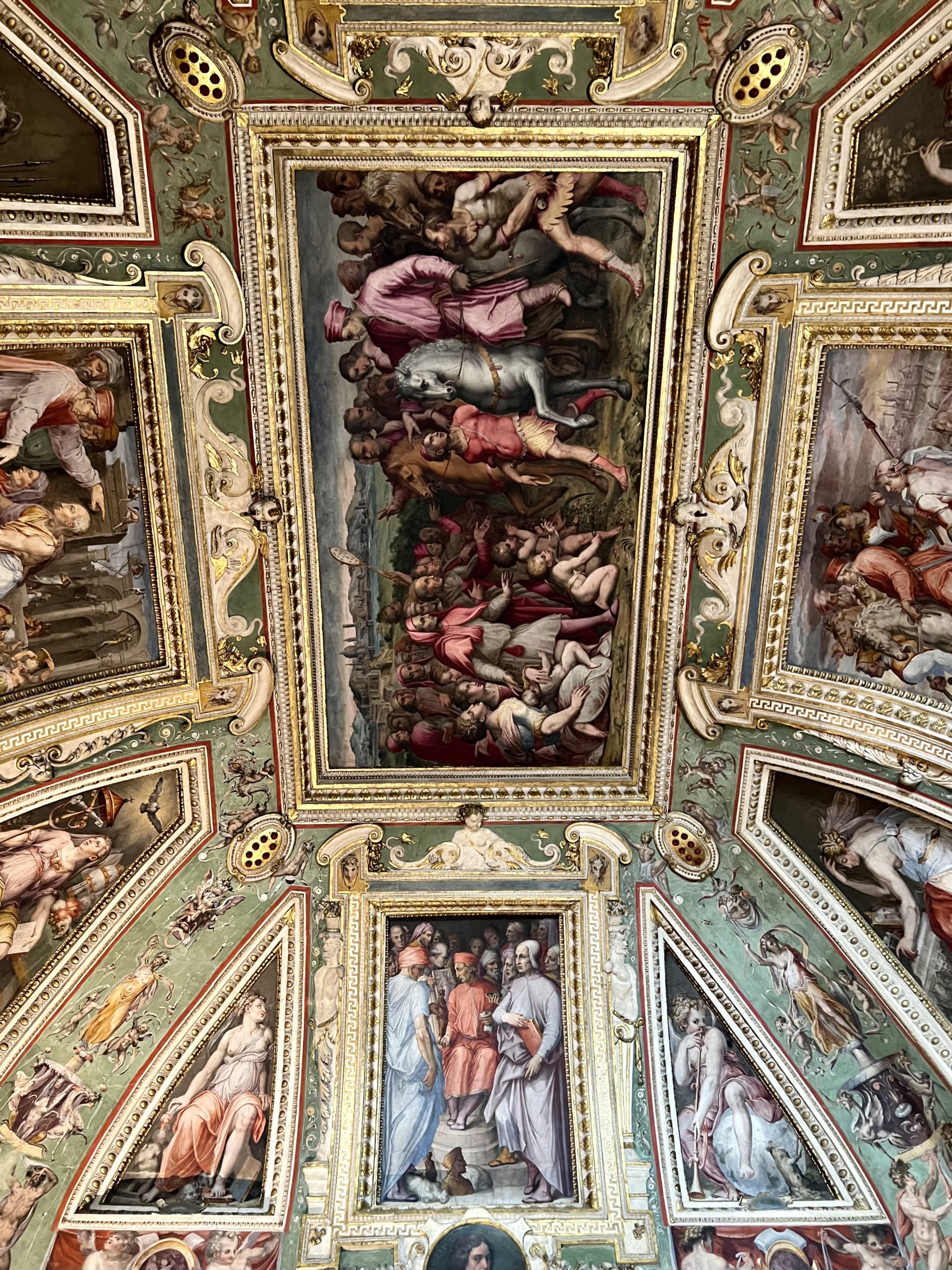
4. The Medici’s Private Rooms
On the second floor are the sumptuously decorated private rooms of the Medici. They consist of elegant apartments, a reception room, small chambers, and a private chapel.
Apartments of Leo X
Each of the rooms in this apartment is dedicated to an illustrious Medici family member — Cosimo the Elder, Lorenzo the Magnificent, Cosimo I, Pope Clement VI, and Leo X.
The rooms were designed by Bartolomeo Ammannati and frescoed by Vasari. The frescos depict scenes of political ad military success.
These rooms mirror the rooms above in the Apartment of the Elements. They were meant to compare the rise of power of the Medici (deities on earth) with the deities of heaven.
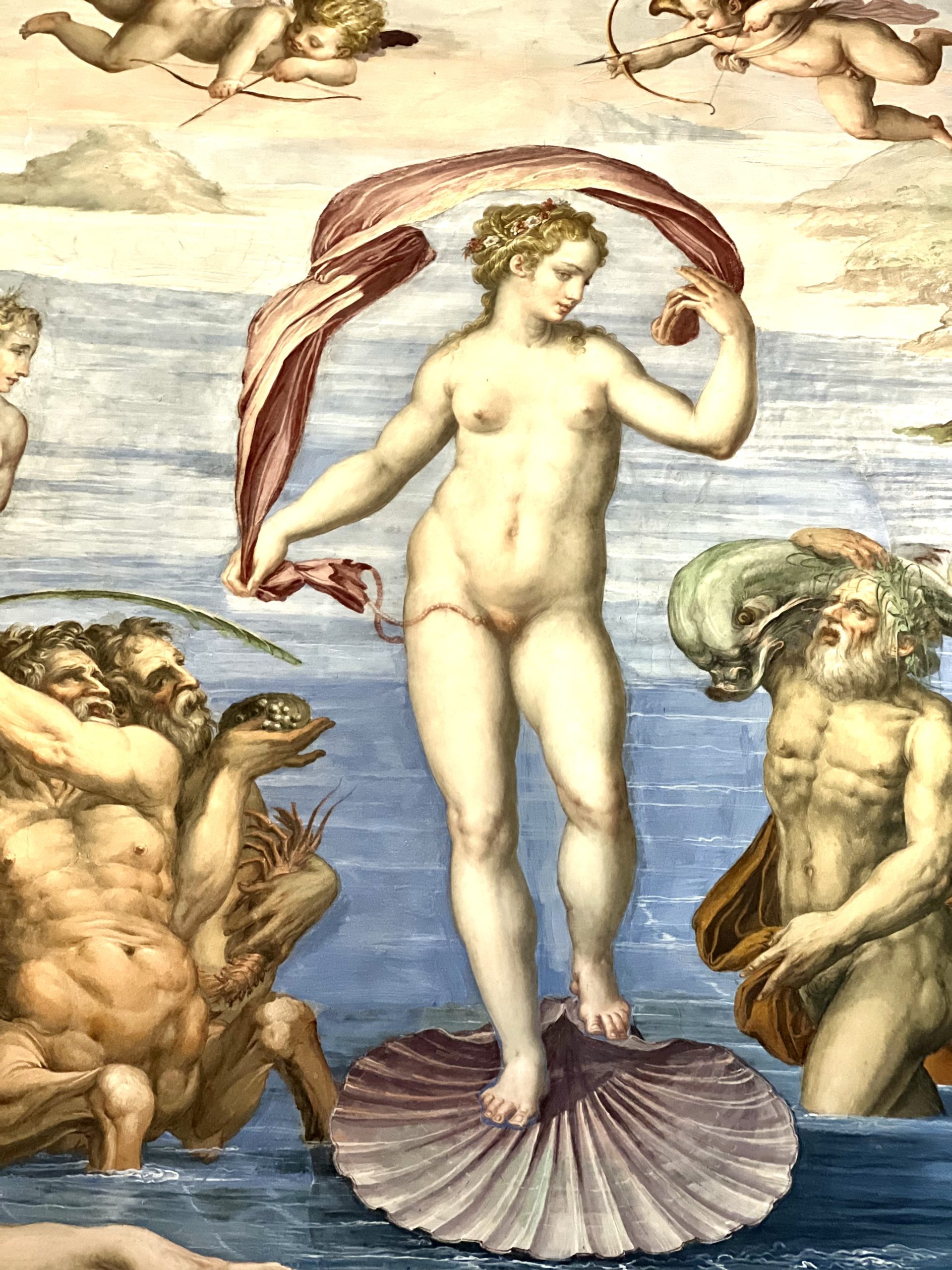
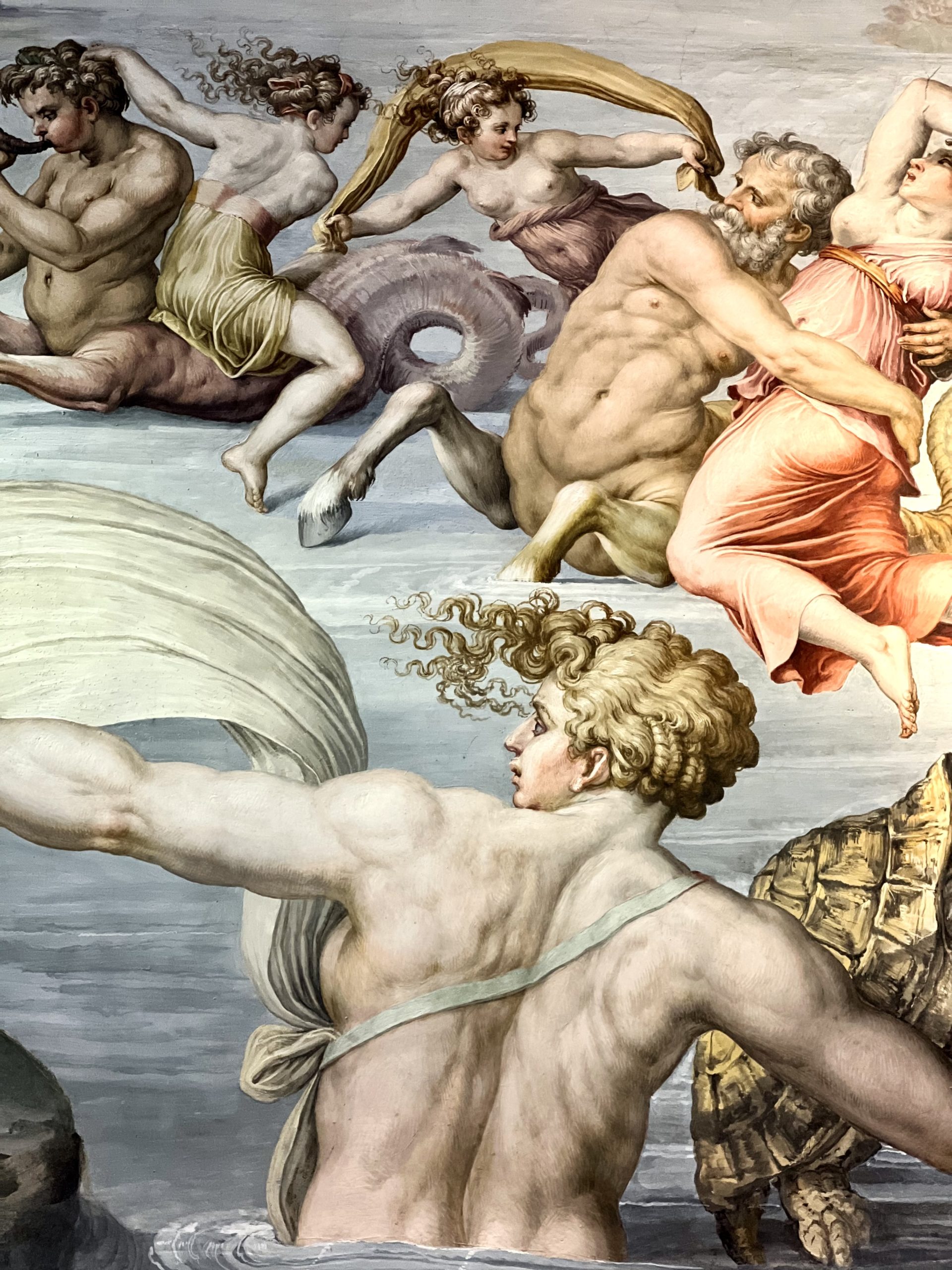
Apartments of the Elements
The Apartments of the Elements, Sala deli Elementi, is newly renovated and simply gorgeous.
It consist of five rooms that make up the quarters of Cosimo I. They are decorated with gorgeous mythological paintings created by Giorgio Vasari and his workshop in 1556-66.
The most stunning room is the Room of the Elements. Its paintings are allegories of the ancient elements of air, water, fire and earth.
Other rooms are dedicates to Saturn’s wife, the goddess Ops, and their descendants.
For a fine view of Florence, you can also step out onto the Loggiato di Saturno in Cosimo’s quarters.
Apartments of Eleonora
You should also visit the Apartments of Eleanora di Toledo, Cosimo’s wife.
On the way, you’ll walk past a terrace with a stunning view of the Hall of Five Hundred. You can see the ceiling from a closer perspective.
The first room is the Green Room, a stunning room with grotesque frescos. It owes its name to the landscape paintings that once decorated the walls, now replaced with a green hue.
Eleonora had her own chapel, which features beautiful frescos painted by the Mannerist painter Bronzino, including The Deposition of Christ.
Other rooms in her apartments have ceilings frescoed by Vasari. The frescos depict scenes of classical heroines in honor of Eleonora.
One room contains a copy of Leonardo’s lost Battle of Anghiari.
5. Hall of the Lilies
The Hall of Lilies is stunning example of early Renaissance interior decoration. The greatest Renaissance artists of the day, who had recently returned from decorating the Sistine Chapel in Vatican City, were commissioned to decorate it.
The hall has spectacular gilded coffered ceilings with gold on blue fleur de lis, the symbol of Florence.
In the Hall of Lilies, you’ll find another precious treasure, the groundbreaking Judith and Holofernes sculpture by Donatello. It was commissioned by Cosimo the Elder.
Judith and Holofernes is an Old Testament story, in which a heroic woman defeats a warlord who’s besieged her town in Israel. She does this by seducing, inebriating, and decapitating him.
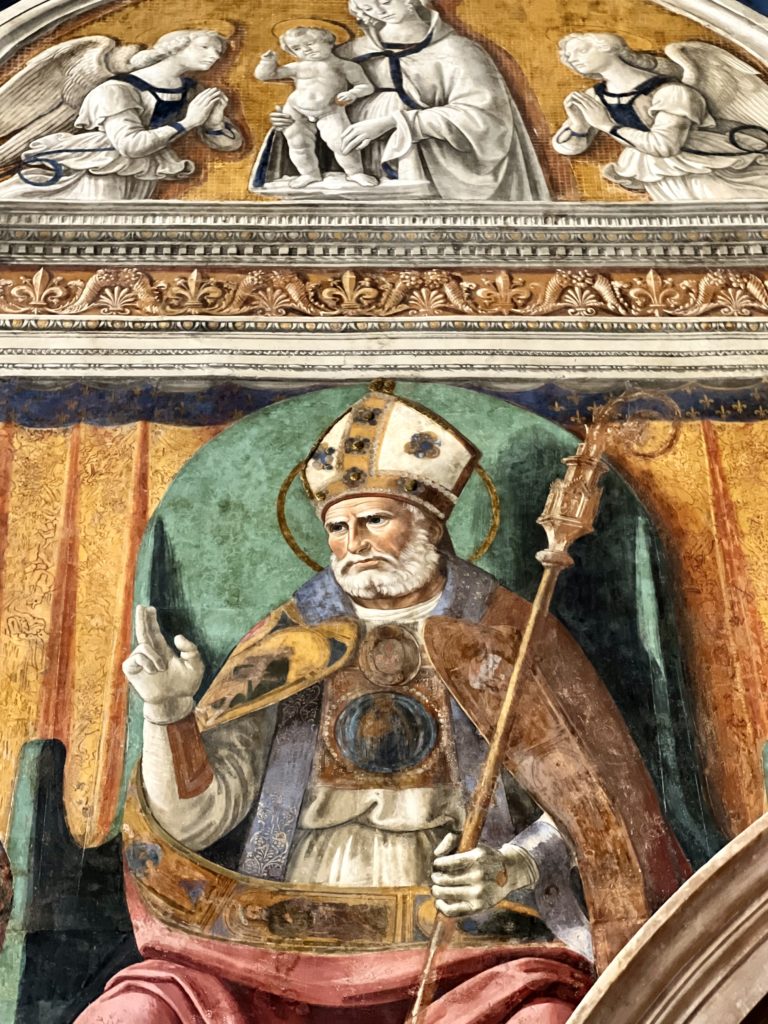
Judith and Holofernes carried forth the Medici’s underdog theme. The statue was first placed in the Medici garden.
When the Medici had a short exile from the city, the citizens moved the statue into the Piazza della Signoria. The original was moved to the Hall of Lilies in 1888.
On the east wall is a fresco series by Domenico Ghirlandaio. It’s a classical composition with faux painted architecture.
6. Hall of Salviati
The Hall of Salviati is named after a noble Florentine family who once owned the palace. It’s on the second floor of the palace and was used as a reception room for guests.
Bernardino Poccetti painted the elaborate frescos that decorate the room. They depict scenes from the life of Cosimo I. Allegorical figures and motifs represent the accomplishments of the Medici.
The fresco is intended to exalt Cosimo I, who also vanquished Florence’s enemies. The chamber also has a beautiful Casetonne-style ceiling covered in gilt.
7. Sala Delle Carte Geographiche
On the second floor, you’ll find the beautiful Map Room. Built by Vasari, it houses Cosimo’s private collection of 16th century maps. The maps chart everywhere in the known world from that century.
Working with an actual cosmographer, Vasari designed a room with constellations painted on the ceiling, wooden cupboards with geographical maps painted on leather panels, and portraits of famous men from history.
In the center stands the famous globe Mappa Mundi, the largest in the world when made in 1581.
This area of the Palazzo Vecchio is currently under renovation and closed. But the are graphics on display in the lobby that show you replicas of the maps.
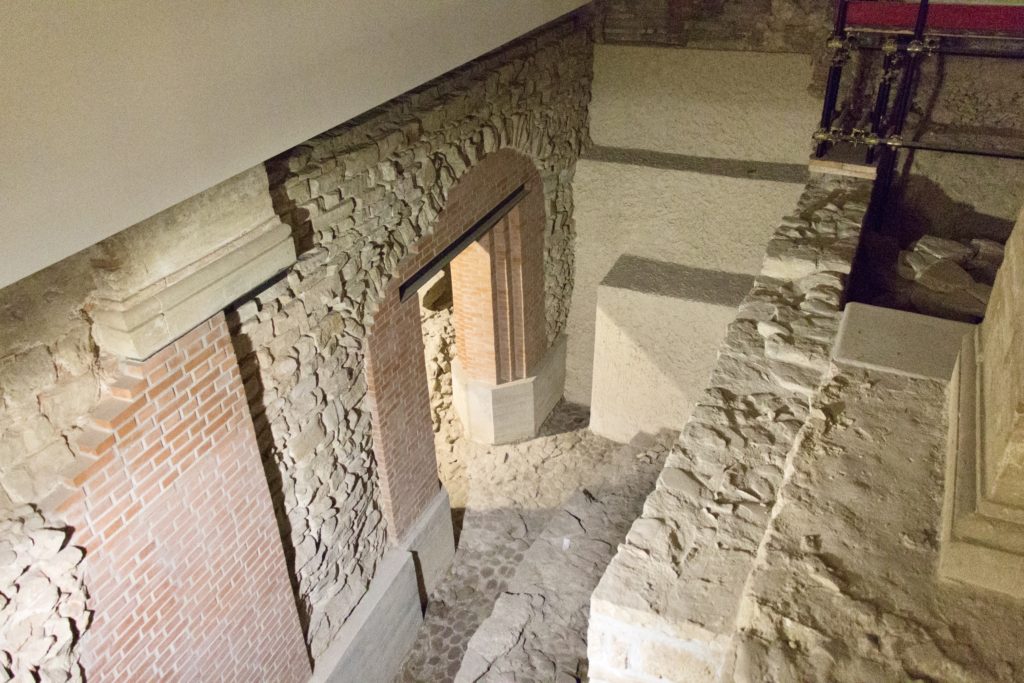
8. Roman Theater of Florentina
Via an underground passage, you can take a peak at the ancient Roman ruins of the Theater of Florentina from the 1st century AD. Palazzo Vecchio was built atop the ruins.
The first remains were excavated in 1876. The semi circular theater seated around 15,000.
The ruins opened to the public in October 2014. To visit, you normally need to make an advance reservation. Right now, the theater is closed due to the pandemic.
9. Tower of Arnolfo
If you’re up for a climb of 418 steps, the Tower of Arnolfo offers panoramic 360 views. You enter via the Museum of Palazzo Vecchio, with a combined ticket for Palazzo Vecchio or for an additional small fee.
On your hike up, you’ll pass a prison cell known as the “Little Hotel.” This is where Cosimo and Savonarola were briefly imprisoned.
This is a great alternative to the long queues at the Giotto Bell Tower. No more than 35 people can enter at once.
On busy days, you’ll be limited to 30 minutes. In bad weather, it’s closed. The tower is steep and cramped, so you need to be fit to venture up.
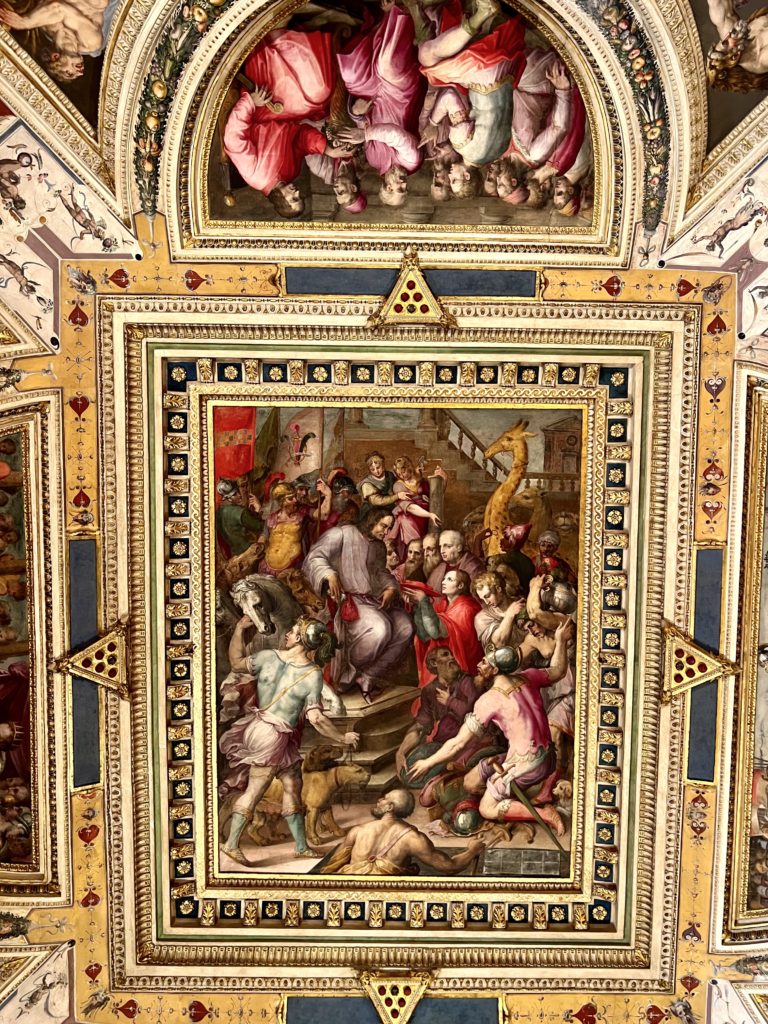
Tickets & Tours For Palazzo Vecchio
If you’re visiting Florence in high season, I would definitely pre-purchase a ticket. Click here to book a skip the line ticket with a time slot reservation.
You can also book a guided tour of the palace. There is a guided secret passages tour with lunch. This guided 2 hour tour covers the palace and the Piazza della Signoria.
Another popular 2 hour guided tour includes the palace and a climb of the Tower of Arnolfo. You can also book a private guided tour.
Practical Guide & Tips for Palazzo Vecchio
Address: Piazza della Signoria
Hours: Friday to Wednesday 9:00 am to 7:00 pm, Thursday 9:00 am to 2:00 pm, From April to September, Mon/Tue/Wed/Fri/Sat/Sun 9:00 am to 11:00 pm.
Entry fee: You can get combination tickets for the museum, archeological site, and the tower. Check prices here.
Pro tips:
Expect to spend at least 90 minutes touring Palazzo Vecchio.
On my last visit, I was astonished at how long it took to exchange my pre-paid voucher for a paper ticket. The office seemed exceedingly disorganized, understaffed, and they were checking names off a hand written list.
It took me approximately 30 minutes to get inside the ticket office and procure my actual ticket. The result was I almost missed my designated time slot entry. If you’re in the same boat, plan ahead and budget time for this process.
I hope you’ve enjoyed my guide to the Palazzo Vecchio. You may enjoy these other Florence travel guides and resources:
- 1 Day In Florence Itinerary
- 2 Days in Florence Itinerary
- 3 Days In Florence Itinerary
- Hidden Gems in Florence
- Best Museums in Florence
- Florence Art Bucket List
- Best Day Trips From Florence
- Free Things To Do In Florence
- Guide to the Medici Palaces
- Who Were the Medici?
Pin it for later.

